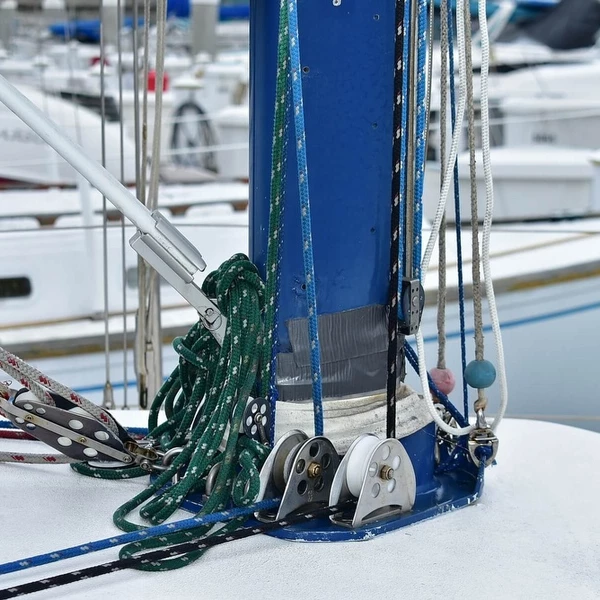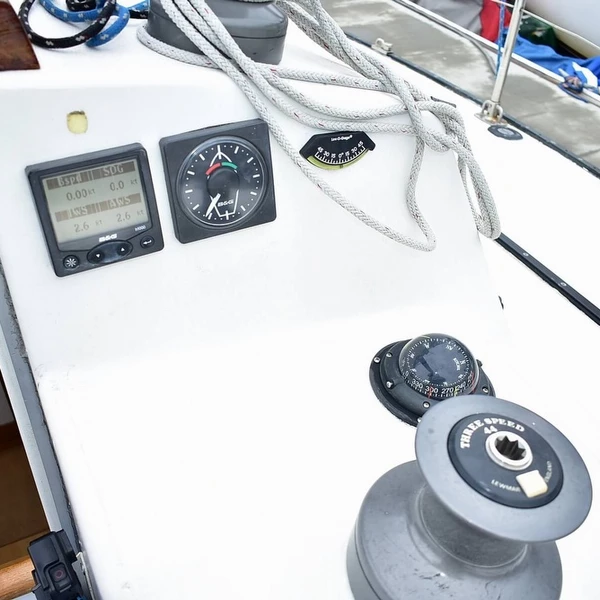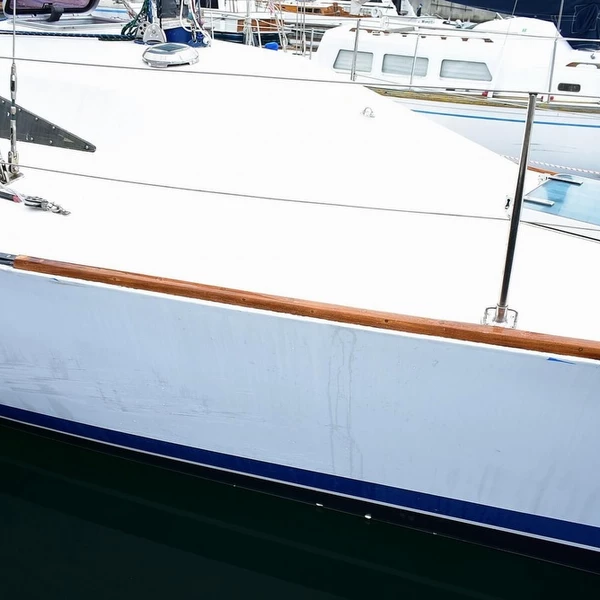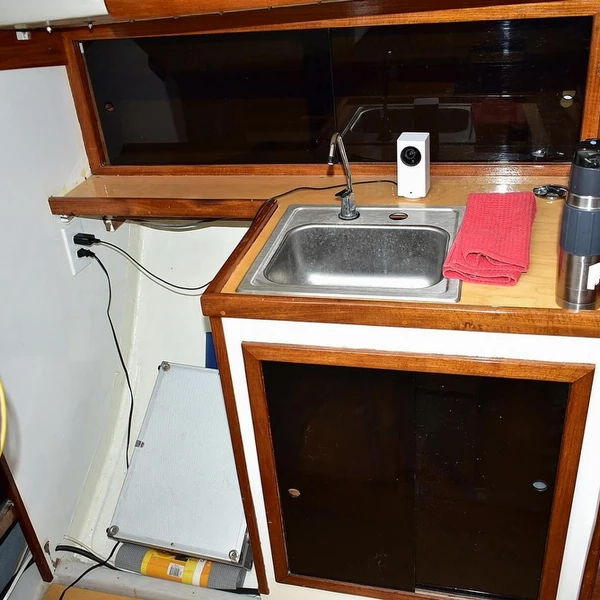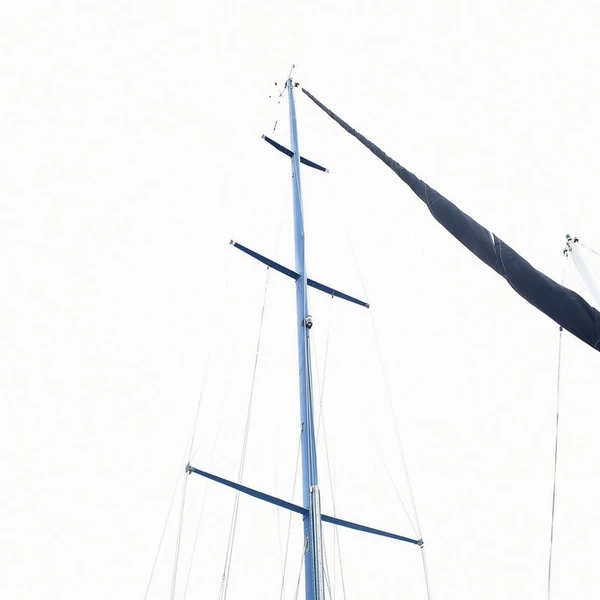Seller's Description
Built by Annapolis Custom Yachts, and designed by Bruce Farr, the Masthead Sloop Farr 33 is a racer to the core.
Carefully chosen Length, beam, displacement distribution, and sail plan gives the Farr 33 great light air performance.
To enhance performance and make the boat easier to single hand, the seller installed Lazy jacks, A sail pack, adjustable genoa lead cars, and additional winches aft. There are 3-speed racing winches throughout.
4 B&G H1000 displays will keep you informed of the conditions, so you’ll always have the knowledge close at hand. The Garmin GPSmap 172C helps you plot your course with GPS and the West Marine VHS keeps you in contact. The GPS is splashed to a large Samsung, so you’ll have quick knowledge of your location. A wifi system attached to the B&G data backbone provides access to all NMEA 0183 for all remote devices.
The Farr 33 will sleep 3, has an electric freshwater head, good sized Ice box and a sink in the galley. There are separate house and engine batteries, so if the next owner added an electric hot plate, there are no worries about power.
A Kubota 3 cylinder 20hp engine spins a Martec folding prop to provide the second form of propulsion.
There are 2 spinnakers in addition to the Mainsail and Jib. To complete the racing package aboard, the backstay also has hydraulics to control the shape of the mast while underway.
Specs
- Designer
- Bruce Farr
- Builder
- Annapolis Custom Yachts (USA)
- Associations
- ?
- # Built
- ?
- Hull
- Monohull
- Keel
- ?
- Rudder
- ?
- Construction
- FG
Dimensions
- Length Overall
- 33′ 9″ / 10.3 m
- Waterline Length
- 26′ 8″ / 8.1 m
- Beam
- 11′ 6″ / 3.5 m
- Draft
- 6′ 9″ / 2.1 m
- Displacement
- 9,240 lb / 4,191 kg
- Ballast
- 2,910 lb / 1,320 kg (Lead)
Rig and Sails
- Type
- Sloop
- Reported Sail Area
- 564′² / 52.4 m²
- Total Sail Area
- 563′² / 52.3 m²
Mainsail
- Sail Area
- 269′² / 25 m²
- P
- 39′ 4″ / 12 m
- E
- 13′ 8″ / 4.2 m
- Air Draft
- ?
Foresail
- Sail Area
- 294′² / 27.3 m²
- I
- 45′ 3″ / 13.8 m
- J
- 12′ 11″ / 4 m
- Forestay Length
- 47′ 1″ / 14.4 m
Auxilary Power
- Make
- Volvo
- Model
- ?
- HP
- 18
- Fuel Type
- Diesel
- Fuel Capacity
- ?
- Engine Hours
- ?
Accomodations
- Water Capacity
- ?
- Holding Tank Capacity
- ?
- Headroom
- ?
- Cabins
- ?
Calculations
- Hull Speed
-
8.0 kn
Classic: 6.92 kn
Hull Speed
The theoretical maximum speed that a displacement hull can move efficiently through the water is determined by it's waterline length and displacement. It may be unable to reach this speed if the boat is underpowered or heavily loaded, though it may exceed this speed given enough power. Read more.
Formula
Classic hull speed formula:
Hull Speed = 1.34 x √LWL
A more accurate formula devised by Dave Gerr in The Propeller Handbook replaces the Speed/Length ratio constant of 1.34 with a calculation based on the Displacement/Length ratio.
Max Speed/Length ratio = 8.26 ÷ Displacement/Length ratio.311
Hull Speed = Max Speed/Length ratio x √LWL
- Sail Area/Displacement
-
20.5
>20: high performance
Sail Area / Displacement Ratio
A measure of the power of the sails relative to the weight of the boat. The higher the number, the higher the performance, but the harder the boat will be to handle. This ratio is a "non-dimensional" value that facilitates comparisons between boats of different types and sizes. Read more.
Formula
SA/D = SA ÷ (D ÷ 64)2/3
- SA: Sail area in square feet, derived by adding the mainsail area to 100% of the foretriangle area (the lateral area above the deck between the mast and the forestay).
- D: Displacement in pounds.
- Ballast/Displacement
-
31.5
<40: less stiff, less powerful
Ballast / Displacement Ratio
A measure of the stability of a boat's hull that suggests how well a monohull will stand up to its sails. The ballast displacement ratio indicates how much of the weight of a boat is placed for maximum stability against capsizing and is an indicator of stiffness and resistance to capsize.
Formula
Ballast / Displacement * 100
- Displacement/Length
-
217.4
200-300: moderate
Displacement / Length Ratio
A measure of the weight of the boat relative to it's length at the waterline. The higher a boat’s D/L ratio, the more easily it will carry a load and the more comfortable its motion will be. The lower a boat's ratio is, the less power it takes to drive the boat to its nominal hull speed or beyond. Read more.
Formula
D/L = (D ÷ 2240) ÷ (0.01 x LWL)³
- D: Displacement of the boat in pounds.
- LWL: Waterline length in feet
- Comfort Ratio
-
18.8
<20: lightweight racing boat
Comfort Ratio
This ratio assess how quickly and abruptly a boat’s hull reacts to waves in a significant seaway, these being the elements of a boat’s motion most likely to cause seasickness. Read more.
Formula
Comfort ratio = D ÷ (.65 x (.7 LWL + .3 LOA) x Beam1.33)
- D: Displacement of the boat in pounds
- LWL: Waterline length in feet
- LOA: Length overall in feet
- Beam: Width of boat at the widest point in feet
- Capsize Screening
-
2.2
>2.0: better suited for coastal cruising
Capsize Screening Formula
This formula attempts to indicate whether a given boat might be too wide and light to readily right itself after being overturned in extreme conditions. Read more.
Formula
CSV = Beam ÷ ³√(D / 64)
- Beam: Width of boat at the widest point in feet
- D: Displacement of the boat in pounds
Notes
Farr design #145.
(IOR: 26.3’).
This listing is presented by PopYachts.com. Visit their website for more information or to contact the seller.










































